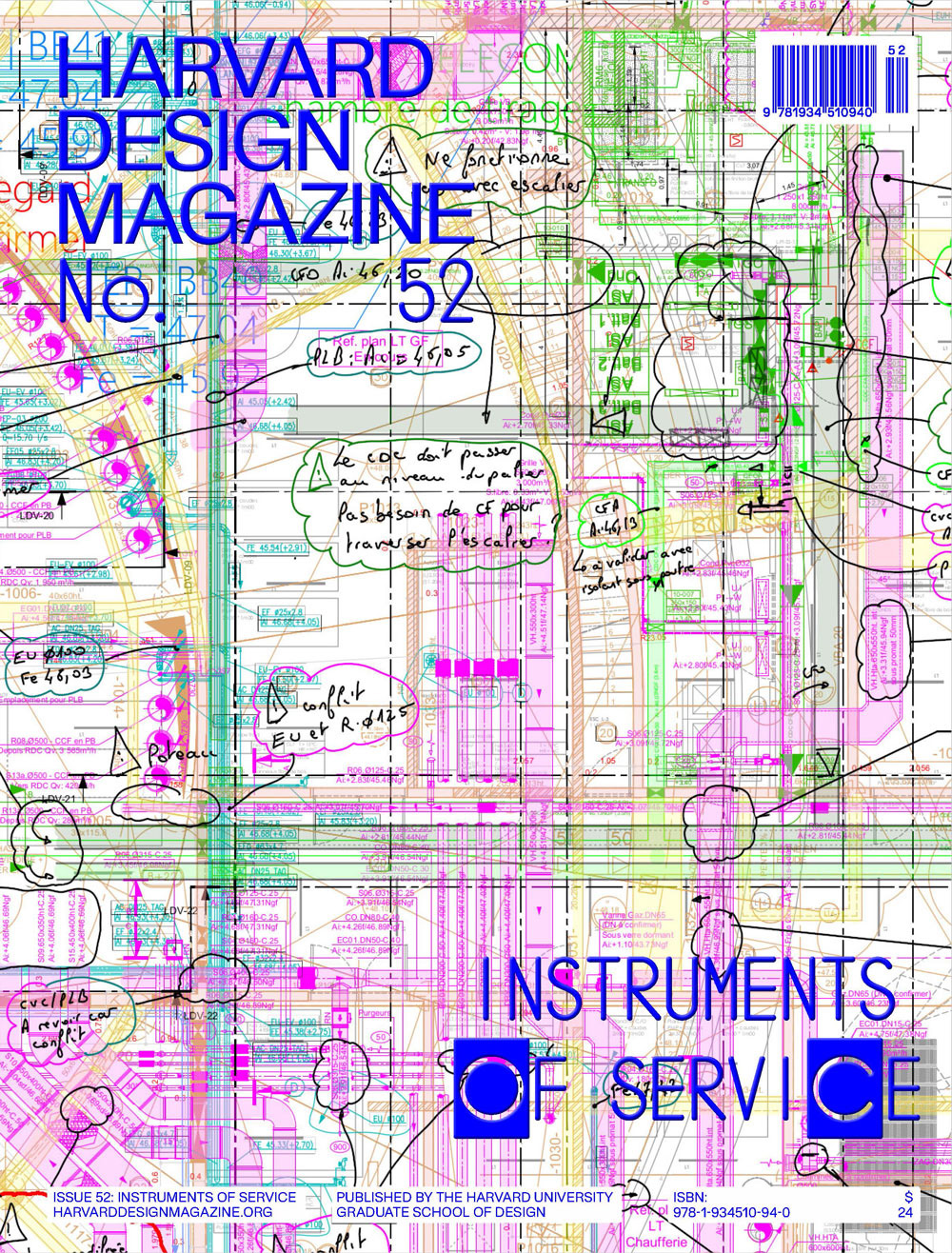Architects, Builders, and the Failed Promise of Deep Collaboration
52: Instruments of Service

At a moment when the word “design” has come to refer to everything and thus nothing, this issue examines the hidden mechanics and visible output of design practice in order to track the shifting role of designers in society and to gauge the capacity of designers to effect change in a world of mounting crises.
The issue poses a simple question: What do architects actually make and how is this changing?
Guest edited by Elizabeth Bowie Christoforetti and Jacob Reidel, assistant professors in practice of architecture at the Harvard Graduate School of Design, issue 52’s exploration is grounded in architecture. Once upon a time asserted to be the “mother art” (Frank Lloyd Wright) and as “the ultimate goal of all creative activity” (Walter Gropius’s introduction to his Bauhaus Manifesto), but over the past century it has lost its purchase on such sweeping and grandiose claims to creative primacy and world-building. At the same time, however, architecture remains a ubiquitous point of reference for a wide range of disciplines, practices, and protagonists that influence the design of the things we use and the environments we inhabit—including fields not only directly related to architecture such as landscape architecture, urban planning, and urban design, but also fashion, industrial design, graphic design, and digital design.
The issue’s title, Instruments of Service, carries a double meaning. As defined in standard American Institute of Architects contracts, “Instruments of Service are representations, in any medium of expression now known or later developed, of the tangible and intangible creative work performed by the Architect and the Architect’s consultants under their respective professional services agreements. Instruments of Service may include, without limitation, studies, surveys, models, sketches, drawings, specifications, and other similar materials.” Instruments of service are the instruction manuals that architects—and other designers—make so that others can make something. They define the architect’s relationships with labor, construction, clients, and society. And these relationships—along with the agency of architectural practice—are changing as a growing number of external pressures force instruments of service to change.
Architects and designers can also be seen as instruments of service to society, responsible to a continually shifting set of values. At a fundamental level, the designer’s job is to imagine and articulate a better future. In a time of crisis and competing value systems—market returns, cultural relevance, environmental response, social equity, automation—the role of the designer in society is ever more important and increasingly accountable to divergent interests that call into question the raison d’être of design practice itself.
In the end, what we make is inextricably tied to why and for whom we make it.
Tyler Coburn and Siqi Zhu with Elizabeth Bowie Christoforetti, George B. Johnston, Grace La, Michael Osman, and Jacob Reidel
Elizabeth Bowie Christoforetti and Jacob Reidel
Elizabeth Bowie Christoforetti and Jacob Reidel
Christopher Alexander
Gregg Garmisa with Phil Bernstein, John Cerone, and Alexis McGuffin
Chelsea Spencer with Bryan E. Norwood and Jay Wickersham
Jeffry Burchard with Evelyn Lee, Jesse M. Ehrenfeld, Mary Smith, and Daniel Susskind
Ingeborg Rocker with Andrew Heumann, Tyler Mincey, and Martha Tsigkari
Ana María León with Andrew Bernheimer, Andrew Daley, Maya Porath, and Fiona Riley
Elizabeth Bowie Christoforetti and Jacob Reidel with Toni L. Griffin, Nikil Saval, and Jack Self
Katie Lloyd Thomas
Matthew Soules
Michael Caton
Reinier de Graaf
Aaron Tobey
Mario Carpo
Aaron Cayer
Renée Cheng
Claire Weisz
Albena Yaneva
George B. Johnston
Farshid Moussavi
Elizabeth Bowie Christoforetti and Jacob Reidel
Sala Elise Patterson
Elizabeth Bowie Christoforetti and Jacob Reidel with Aaron Pine
EDITOR IN CHIEF
Ken Stewart
MANAGING EDITOR
Meghan Ryan Sandberg
GUEST EDITORS
Elizabeth Bowie Christoforetti
Jacob Reidel
GRAPHIC DESIGN & ART DIRECTION
Alexis Mark
COPYEDITOR
Rachel Holzman
PROOFREADER
Mikhail Grinwald
RESEARCHERS
Robin Albrecht
Juman Barazi
Elitza Koeva
Pablo Castillo Luna
Vivienne Shi
SOCIAL MEDIA & MARKETING
Gillian Hause
Kate Schreiber